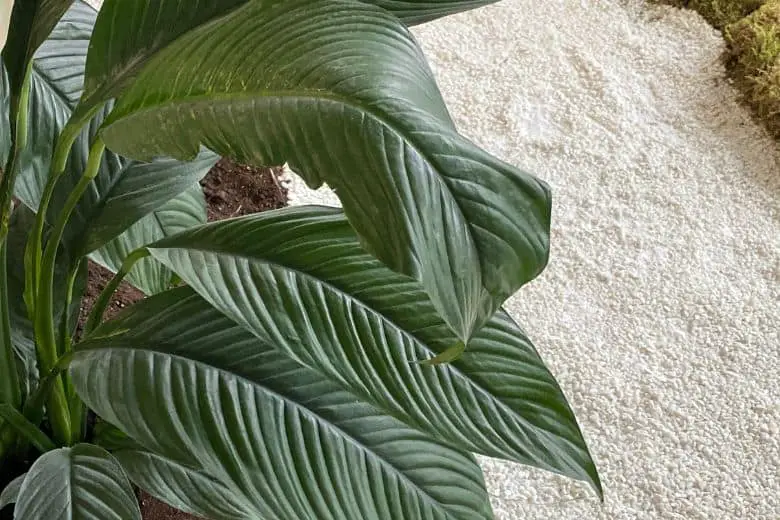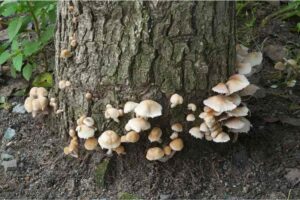
Peace Lilies are a popular houseplant because of their elegant, white flowers and lush green leaves. Unfortunately, Peace Lilies can suffer from a few problems, one of which is curled leaves.
Curled leaves are a sign that the plant is not receiving the right amount of nutrients, and can be caused by several different factors. Poor soil, low humidity, and too much sun or too little water can all cause Peace Lily leaves to curl.
It’s important to identify the source of the problem and take steps to correct it in order to keep your Peace Lily healthy and ensure it blooms properly.
Causes of Curling Peace Lily Leaves
Peace Lily plants (Spathiphyllum) are generally easy to care for but certain conditions can cause their leaves to curl. Here are some potential causes for curling leaves in Peace Lily:
- Underwatering: If you’re not giving your Peace Lily enough water, the plant may respond by curling its leaves. Peace Lilies prefer consistently moist soil. However, you should avoid overwatering as this can lead to root rot.
- Overwatering: On the flip side, overwatering can also cause the leaves of your Peace Lily to curl. Too much water can lead to root rot, which in turn will cause the plant to suffer as it can’t take up water and nutrients properly.
- Temperature Stress: Peace Lilies are tropical plants and they prefer warm temperatures. If the temperature drops too low, particularly at night, the leaves can curl. Aim for a consistent temperature between 65-80°F (18-27°C).
- Light Stress: Peace Lilies prefer bright, indirect light. If they receive too much direct sunlight, their leaves can become scorched and begin to curl.
- Nutrient Deficiency: If your Peace Lily isn’t getting the nutrients it needs, the leaves can start to curl. They need a balanced, water-soluble fertilizer applied about every 6 weeks during the growing season.
- Pest Infestation: Pests, such as aphids, mealybugs, and spider mites, can cause the leaves to curl as they suck sap from the plant. Inspect your plant regularly for any signs of pests.
- Poor Quality Water: Peace Lilies can be sensitive to the type of water used. Tap water contains chlorine, which can cause the leaves to curl or yellow. Consider using distilled or rainwater for watering these plants.
Signs of Curling Peace Lily Leaves
If you’ve noticed your peace lily leaves curling, there are several possible explanations.
- Curled Leaves: The most obvious sign is the curling of leaves inwards or sideways.
- Yellowing or Browning: Accompanying the curling, the leaves may turn yellow or brown, often indicating overwatering or underwatering.
- Wilting: The plant may wilt, even when the soil is wet, a sign of potential root rot due to overwatering.
- Dry, Crispy Edges: If the edges of the leaves become dry and crispy, it may be a sign of underwatering or too much direct sunlight.
- Spotted or Patchy Leaves: If there are spots or patches on the leaves, this could indicate exposure to too much light or a nutrient deficiency.
- Visible Pests: If you see small pests or sticky residue on the leaves or nearby surfaces, it may indicate a pest infestation causing the curling.
- Stunted Growth: The plant may have stunted growth or stop growing altogether, which can be a sign of a nutrient deficiency.
How to Prevent Curling Peace Lily Leaves
Preventing Peace Lily leaves from curling involves taking proper care of the plant. Here are some tips:
Proper Watering: Avoid both underwatering and overwatering. The soil should be kept moist but not soggy. A good rule is to water when the top inch of the soil feels dry.
Ideal Temperature: Maintain a temperature between 65-80°F (18-27°C). Peace Lilies are tropical plants and do not do well in cold conditions.
Appropriate Lighting: Place the Peace Lily in a location with bright, indirect light. Too much direct sunlight can scorch the leaves and cause them to curl.
Fertilize Correctly: Use a balanced, water-soluble fertilizer every 6 weeks during the growing season. However, be careful not to over-fertilize, as this can also cause leaf curl.
Pest Control: Regularly inspect your plant for pests. If detected, use appropriate pest control methods such as insecticidal soaps or neem oil.
Proper Water Quality: Use filtered, distilled, or rainwater to avoid harmful chemicals often found in tap water, such as chlorine, which can cause the leaves to curl or yellow.
Good Drainage: Make sure your pot has good drainage to prevent waterlogging and root rot. If necessary, consider repotting in a pot with better drainage.
Humidity: Being tropical plants, Peace Lilies prefer higher humidity. Consider using a pebble tray filled with water or a humidifier to increase humidity around the plant.
With proper care and attention to these details, you can prevent the leaves of your Peace Lily from curling.

How to Treat Curling Peace Lily Leaves
One of the most beautiful and easy to care for houseplants is the peace lily (Spathiphyllum). Unfortunately, its leaves can often curl, making it look less than its best. Fortunately, this is a relatively easy problem to fix. A few simple steps can help return your peace lily to its former glory.
Step 1: Identify the Problem
Look at the plant closely to understand what’s causing the curling leaves. Is the plant getting too much or too little water? Is it exposed to the wrong amount of light? Are there signs of pest infestation? Identifying the problem is the first step.
Step 2: Adjust Watering Routine
If the plant is being overwatered or underwatered, correct this. Wait until the top inch of soil is dry to the touch before watering. When watering, do so thoroughly, allowing excess water to drain out.
Step 3: Change Location
If the plant is receiving too much direct light, move it to a spot that gets bright but indirect sunlight. If it’s not getting enough light, move it to a brighter location.
Step 4: Modify Temperature
If the plant is kept in a spot that’s too cold, move it to a warmer location. Ideal temperatures for a Peace Lily are between 65-80°F (18-27°C).
Step 5: Feed the Plant
If the leaves show signs of nutrient deficiency, such as yellowing or slow growth, feed the plant a balanced, water-soluble fertilizer. Follow the instructions on the fertilizer packaging.
Step 6: Pest Control
Check the plant regularly for pests. If any are found, treat the plant with an appropriate insecticidal soap or a mild solution of neem oil and water.
Step 7: Improve Water Quality
If you’ve been using tap water to water the plant, switch to distilled, filtered, or rainwater. Peace Lilies can be sensitive to the chemicals in tap water.
Step 8: Increase Humidity
Peace Lilies prefer higher humidity. Consider using a pebble tray with water or a humidifier to increase humidity around the plant.
Step 9: Monitor and Repeat
Continue to monitor the plant and repeat the necessary steps until it recovers. If the plant does not improve, consider consulting a plant expert or extension service for additional assistance.
Benefits of Pruning Curling Peace Lily Leaves
Pruning Curling Peace Lily leaves is essential for the health and vitality of the plant. It helps maintain the plant’s shape, encourages growth and blooms, and helps to prevent diseases.
Pruning also helps create a bushier, fuller plant, which can make a beautiful addition to any home or office.
Therefore, pruning helps reduce the amount of dust and debris that is created on the leaves. It can also help to eliminate any dead or damaged foliage, allowing for healthier growth in the future.
Pruning Curling Peace Lily Leaves is a simple but effective way to ensure that your plant remains looking healthy and vibrant.
FAQs About the Why Peace Lily Leaves Curl
What causes peace lily leaves to curl?
Answer: Peace lily leaves curl due to a number of environmental factors, such as too much light, too little light, too much or too little water, too much fertilizer, and even changes in temperature.
How can I fix peace lily leaves that are curling?
Answer: To fix peace lily leaves that are curling, you can try adjusting the light, water, and fertilizer levels, and also checking the temperature of the area where the plant is located. Additionally, you may want to prune any damaged or yellowing leaves.
Is curling a sign of a more serious problem with my peace lily?
Answer: Curling is usually a sign of environmental stress, but it can also be indicative of a more serious problem, such as root rot or bacterial or fungal infestations. If the leaves don’t improve after adjusting the environmental factors, you may need to seek professional help.
Conclusion
The peace lily is a common houseplant that is prized for its beauty and ease of care. It is also known for having leaves that curl inwards when it is not receiving enough water or light. The leaves curl inwards to protect the plant from further damage. By curling inwards, the leaves help to reduce the amount of water lost through evaporation and conserve energy from photosynthesis. Additionally, the leaves curl to help protect the plant from intense light and heat, which can cause the leaves to scorch and wilt. Therefore, it is important to ensure that your peace lily is receiving adequate water and light to prevent its leaves from curling.








One Comment